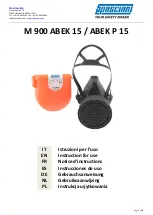
74
Voice Parameters: page 3
Control knob Parameter
Range
Description
1
Key Lock
(Chromatic octave)
Lock keyboard to a certain key. No effect
if Scale = Chromatic or Micro#(x).
2
Scale
38 presets
+ 32 Micro scales
See Custom Scale below; see
for preset scales; see
for Microtuning operations.
3
Microtuning
Scale
Scale name
Visible when a microtuning scale is
selected. see
for
Microtuning functions.
4
Scale Edit
(access)
Enter Scale Edit page (visible when Scale
= Custom)
8
Snap
Off, On
Quicker attack, for sharp initial transients
Key Lock
The Key Lock parameter works with the preset scales to specify which notes the keyboard is
allowed to play. It only applies to preset scales (not Custom, Chromatic, or Microtuning).
Select a Scale
There are 38 preset scales and 32 microtuning
scales available. If you don’t find the one you
want, you can create a custom 12-tone scale
inside the Hydrasynth Deluxe or import new
microtuning scales.
When a non-chromatic scale is selected, notes
that are not in the scale are filtered out. So if
you play notes outside of the selected scale,
they will be quantized to the pre-determined
scale notes. This also affects the incoming
MIDI notes.
However, outgoing MIDI notes are not
affected; if C#3 is not in the scale and you play
the C#3 key, a C#3 will be transmitted over
MIDI and USB.
For a list of the scales and the notes they
contain, See
. For information
about working with microtuning scales, see
.
Custom Scale
The Custom scale option is located at the bottom of the scale list. To get there from Voice page
3, turn Control knob 2 fully counter-clockwise.
Scale Edit
After the Custom scale is selected, press
Control button 4 to enter the Scale Edit page.
Here’s what you’ll see:
• Control button 1: This is the first note in the
custom scale, and it is based upon the Key
Lock setting. The Control knob is disabled.
• Control knobs 2-8: These represent notes
2-8 of the custom scale.
Quick assign
To assign notes quickly to the custom scale,
hold Control button 1 and play the desired
notes on the keyboard. The existing notes will
be cleared as soon as you play the first note.
Note that if the root note is entered it will be
ignored (it’s the Key). It’s okay to enter the notes
out of order; they’ll be placed in chromatic
order when Control button 1 is released.
















































